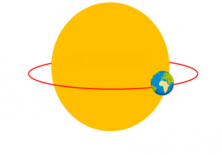In today’s post, we will look at the origins of the months in a year.
Throughout history, the act of telling time has been a necessity for human beings. Wanting to have more control over time, mankind took the approach of a chronological division of semantic time.
 We presume that an astronomical year lasts 365 days, 5 hours, 48 minutes and 46 seconds, which is the time it takes the Earth to revolve around the Sun. With the first calendars, mankind was able to predict the seasons, which should always start on the same dates. This favors more efficient planting and harvesting control, which would allow them to plan out their lives better.
We presume that an astronomical year lasts 365 days, 5 hours, 48 minutes and 46 seconds, which is the time it takes the Earth to revolve around the Sun. With the first calendars, mankind was able to predict the seasons, which should always start on the same dates. This favors more efficient planting and harvesting control, which would allow them to plan out their lives better.
To make these calendars, originally the lunar cycles were taken as reference. However, that generated many difficulties for controlling agriculture, because the lunar calendar did not fit with the solar year.
Later, because of this need, solar calendars appeared. In 46 B.C., Julius Caesar set the year duration to 365 days and 6 hours. In order for these 6 hours not to accumulate year after year, they included an extra day every 4 years: 6 hours x 4 = 24 hours (one day). These years are called leap years.
But as we can see, the model of Julius Caesar, called the Julian Calendar, was a little longer than the astronomical:
 Therefore in 1582, XVI centuries after the Julian calendar came into use, they had to skip from one day to another from October 4 to October 15, obliterating 10 days because of those more than 11 minutes the Julian calendar had.
Therefore in 1582, XVI centuries after the Julian calendar came into use, they had to skip from one day to another from October 4 to October 15, obliterating 10 days because of those more than 11 minutes the Julian calendar had.
In order for this not to happen again, Pope Gregory XIII replaced the Julian calendar with the Gregorian calendar. He adjusted this gap by applying these conditions to leap years:
- Multiples of 4.
- Not divisible by 100.
- If it is a multiple of 400 is also a leap year.
So the year 1700 was not a leap year, and 2000 was.
Even with so many conditions, the Gregorian year is 26 seconds longer than the astronomical year. This means there is a difference of one day every 3323 years. It has therefore been proposed to take a day every four thousand years, i.e the year 4000, 8000 and 16000 will not be leap years (though they would be with the previously discussed rules).
Why are the months of the years named as they are?
The origin of our months dates back to the ancient Roman calendar that only had 10 months.
- Martius was the first month of the old Roman calendar and was named after Mars, the god of war. This was because during this month was when all military campaigns took place. Our month of March.
- Aprilis derived from aperire (Aperta), which means open because it is when the flowers bloom. And the month of Aphrodite, goddess of love. Our month of April.
- Maius dedicated to Maia, one of the oldest goddesses of Rome (May).
- Junio, dedicated to the Etruscan goddess Juno, goddess of marriage (June).
The remaining months of the year acquired its name based on numerical order:
- Quintilis, fifth (July)
- Sextilis, sixth (August)
- September, seventh (September)
- October, eighth (October)
- November, ninth (November)
- December, tenth (December)
At first, two months were ignored. About 61 days, as you can see if you count the months described above. The ignored months were in the winter. During the period that occupied these months was a festival period waiting for the spring. A significant gap in the seasons was present with the passage of time. The solution to this problem was achieved with Numa Pompilius, adding the remaining two months: Januarius and Februarius, as the two missing winter months.
- Januarius dedicated to Jano god of gates, at the beginning of the year (January).
- Februarius dedicated to Pluto (Februus), the god of hell, of the dead (February).
In the imperial era, quintilis and sextilis were replaced by July and August in honor of Julius Caesar and Octavius Augustus.
In conclusion, the months of the year are 12 units of time in which we divide the year, including the passage of seasons and the amount of time it takes the Earth to make its way around the sun.
Thus leaving our current calendar:
 I hope you liked this post and you’ve learned something new. Someday we’ll talk about the division of the months of the year in weeks, days, hours, minutes and seconds. Meanwhile, keep enjoying more activities on Smartick.
I hope you liked this post and you’ve learned something new. Someday we’ll talk about the division of the months of the year in weeks, days, hours, minutes and seconds. Meanwhile, keep enjoying more activities on Smartick.
Have a nice week!
Learn More:
- Math Can Explain Why 2020 Is a Leap Year
- Learn How to Measure Time and the Units Associated
- Learn How to Solve a Time Word Problem
- Time Measurement Problems: Simple and Complex Forms
- What Is a Number? Learn to Count up to 9







